
NCERT Solutions for Class 7 Science Chapter 12
NCERT Solutions for Class 7 Science Chapter 12: This page consist of details solution of chapter Reproduction in Plants class 7 science . You can check NCERT Solutions for class 7 Science for other chapters of class 7 science, do the questions by yourself and check your solution for the chapter Reproduction in Plants.
NCERT Solutions for Class 7 Science Chapter 12 Reproduction in Plants Overview
These crucial subjects are covered in NCERT Solutions Class 7 Science Chapter 12. To grasp the concepts presented in the chapter and effectively utilize the provided solutions, students are encouraged to carefully study each topic. The intention is for students to effortlessly achieve high exam scores after reviewing and practicing these solutions.NCERT Solutions for Class 7 Science Chapter 12 Reproduction in Plants
While solving science specifically for class 7 you need lots of resource to excel in class 7 science to give you edge we uploaded additional questions of class 7 science for solid foundation of class 7 science , uploaded detail theory of class 7 science with added additional Notes & Questions.
| CBSE Syllabus Class 7 | |
| CBSE Class 7 English Syllabus | CBSE Class 7 Math Syllabus |
| CBSE Class 7 Social Science Syllabus | CBSE Class 7 Science Syllabus |
NCERT Solutions for Class 7 Science Chapter 12 Exercise 1
Question 1: Fill in the blanks:
(a) Production of new individuals from the vegetative part of parent is called ________.
(b) A flower may have either male or female reproductive parts. Such a flower is called _________.
(c) The transfer of pollen grains from the anther to the stigma of the same or of another flower of the same kind is known as _________.
(d) The fusion of male and female gametes is termed as __________.
(e) Seed dispersal takes place by means of _________, _________ and _________.
Answer: (a) Production of new individuals from the vegetative part of parent is called vegetative propagation . (b) A flower may have either male or female reproductive parts. Such a flower is called unisexual . (c) The transfer of pollen grains from the anther to the stigma of the same or of another flower of the same kind is known as pollination . (d) The fusion of male and female gametes is termed as fertilisation . (e) Seed dispersal takes place by means of wind , water and animals .
Question 2: Describe the different methods of asexual reproduction. Give examples. Answer: The various modes of asexual reproduction in plants are as follows:
(i) Vegetative propagation: It is the ability of a plant to produce new plants from roots, stems, leaves, and buds. Vegetative propagation is divided into two types.
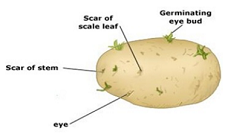
Natural vegetative propagation: This type of vegetative propagation occurs easily in nature and involves simple vegetative parts. Potato plant sprouting from an eye is a common example.
Artificial vegetative propagation: This type of vegetative propagation is performed manually and generally occurs in laboratory conditions. The formation of a complete plant from a stem cutting of rose is a common example of this method.
(ii) Budding: It involves the formation of a new individual from a bulb-like projection called a bud. The bud grows and gets detached from the parent to form a new individual. It is commonly observed in yeast.
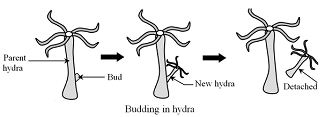
(iii) Fragmentation: It is a form of asexual reproduction where a new organism is formed from the fragments of the parent body. It is the only mode of asexual reproduction in Spirogyra.
(iv) Spore formation: Many non-flowering plants reproduce through spore formation. Spores are tiny cells protected by a thick wall. Fungi such as bread moulds reproduce asexually using this method.
Question 3: Explain what you understand by sexual reproduction.
Answer: Sexual reproduction is a process which involves production of seeds. It requires two parents. Most plants reproduce sexually with the help of flowers. The main function of a flower is to reproduce and therefore develop new seeds that can grow into new plants.
Question 4: State the main difference between asexual and sexual reproduction.
Answer: Differences between sexual and asexual reproduction:
|
Asexual reproduction |
Sexual reproduction |
|
It requires only one parent. |
It requires two parents. |
|
In asexual reproduction, newlydeveloped plants are identical to the parent and to each other. |
In sexual reproduction, newly developed plantsare not identical to parents. |
|
Special reproductive parts are notrequired for asexual reproduction. |
Flower is the reproductive part of a plant whichcontains the sexual organs of a plant. These are important for sexual reproduction. |
|
Examples are yeast, rose, jasmine,potato, etc. |
Examples are flowering plants, such as Hibiscus,corn, papaya, etc. |
Answer:
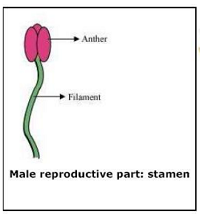
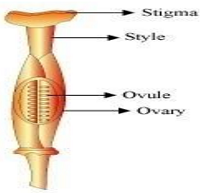
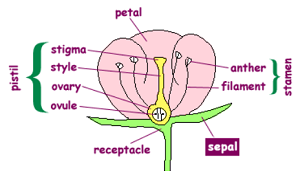
Question 6: Explain the difference between self-pollination and cross-pollination.
Answer: Differences between self-pollination and cross-pollination:

|
Self-pollination |
Cross-pollination |
|
It involves the transfer of pollen from the stamen to the pistil of the same flower. |
It involves the transfer of pollen from the stamen of one flower to the pistil of another flower of the same plant or that of a different plant of the same kind. |
|
It occurs only in bisexual flowers. |
It occurs in both unisexual and bisexual flowers. |
Answer: When pollen lands on stigma, it germinates and gives rise to a pollen tube that passes through the style and reaches the ovary of a pistil. When the pollen tube reaches an ovule, it releases the male gametes. A male gamete fuses with a female gamete in the ovule. This process is known as fertilisation. The cell which is formed after the fusion of a male and a female gamete is known as zygote. This zygote divides several times in order to form the embryo present inside the seed.
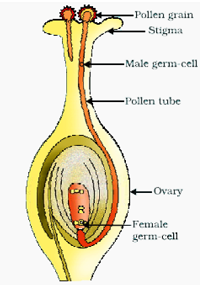
Process of fertilisation
Question 8: Describe the various ways by which seeds are dispersed.
Answer: Seed dispersal occurs by the following agencies.
(a) Dispersal by animals − There are many ways by which birds and animals can disperse seeds. For example, birds and animals can eat the fruits and excrete the seeds away from the parent plant. Some seeds have barbs or other structures that get attached to the animal’s body and are carried to new sites. Some fruits have hooks on them which cling to fur or clothes.
(b) Dispersal by wind − Seeds that get dispersed by wind are usually smaller in size or they have wings or hair-like structures. For example, winged seeds of drumsticks, hairy fruit of sunflower, etc. are dispersed by wind.
(c) Dispersal by water − Many aquatic plants or plants that live near water has seeds that can float and are carried away by water. For example, coconuts can float and are dispersed by water.
(d) Dispersal by explosion − Sometimes the seeds are dispersed by the bursting of fruits with sudden jerks. The seeds get scattered or distributed far from the parent plant. Examples of such plants are castor and balsam.
Question 9: Match items in Column I with those in Column II:
|
Column I |
Column II |
|
(a) Bud |
(i) Maple |
|
(b) Eyes |
(ii) Spirogyra |
|
(c) Fragmentation |
(iii) Yeast |
|
(d) Wings |
(iv) Bread mould |
|
(e) Spores |
(v) Potato |
|
(vi) Rose |
Answer:
|
Column I |
Column II |
|
(a) Bud |
(iii) Yeast |
|
(b) Eyes |
(v) Potato |
|
(c) Fragmentation |
(ii) Spirogyra |
|
(d) Wings |
(i) Maple |
|
(e) Spores |
(iv) Bread mould |
(a) The reproductive part of a plant is the
(i) leaf
(ii) stem
(iii) root
(iv) flower
(b) The process of fusion of the male and female gametes is called
(i) fertilisation
(ii) pollination
(iii) reproduction
(iv) seed formation
(c) Mature ovary forms the
(i) seed
(ii) stamen
(iii) pistil
(iv) fruit
(d) A spore producing plant is
(i) rose
(ii) bread mould
(iii) potato
(iv) ginger
(e) Bryophyllum can reproduce by its
(i) stem
(ii) leaves
(iii) roots
(iv) flower
Answer: (i) d. flower, (ii) a. fertilization, (iii) d. fruit, (iv) b. bread mold, (v) b. leaves
NCERT Solutions for Class 7 Science Chapter 12 FAQs
What are the different modes of reproduction in plants covered in Chapter 12?
What is sexual reproduction in plants?
How is asexual reproduction explained in this chapter?
What is the role of flowers in plant reproduction, and how is it explained in this chapter?
Can I find examples of both sexual and asexual reproduction in plants in this chapter?









